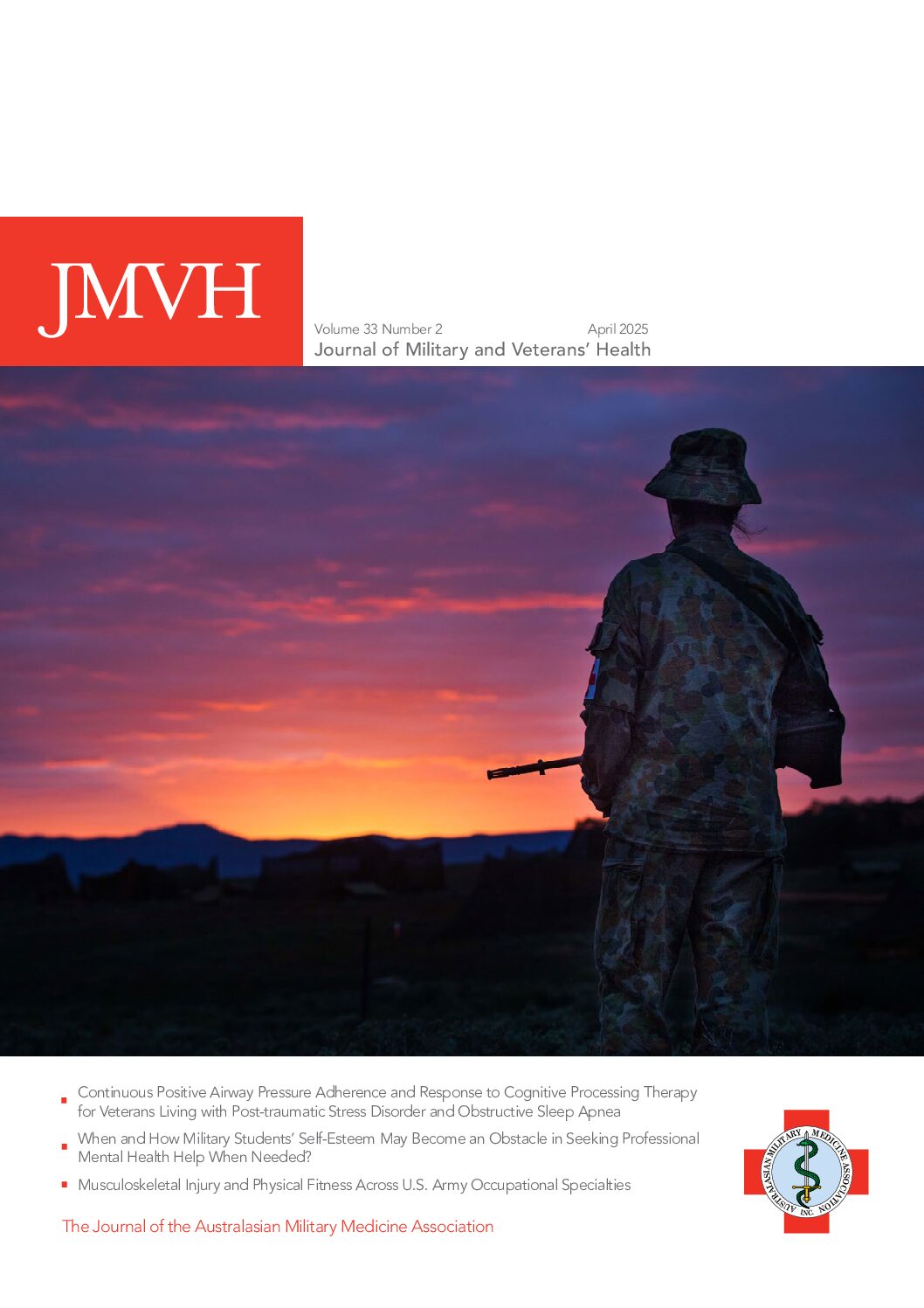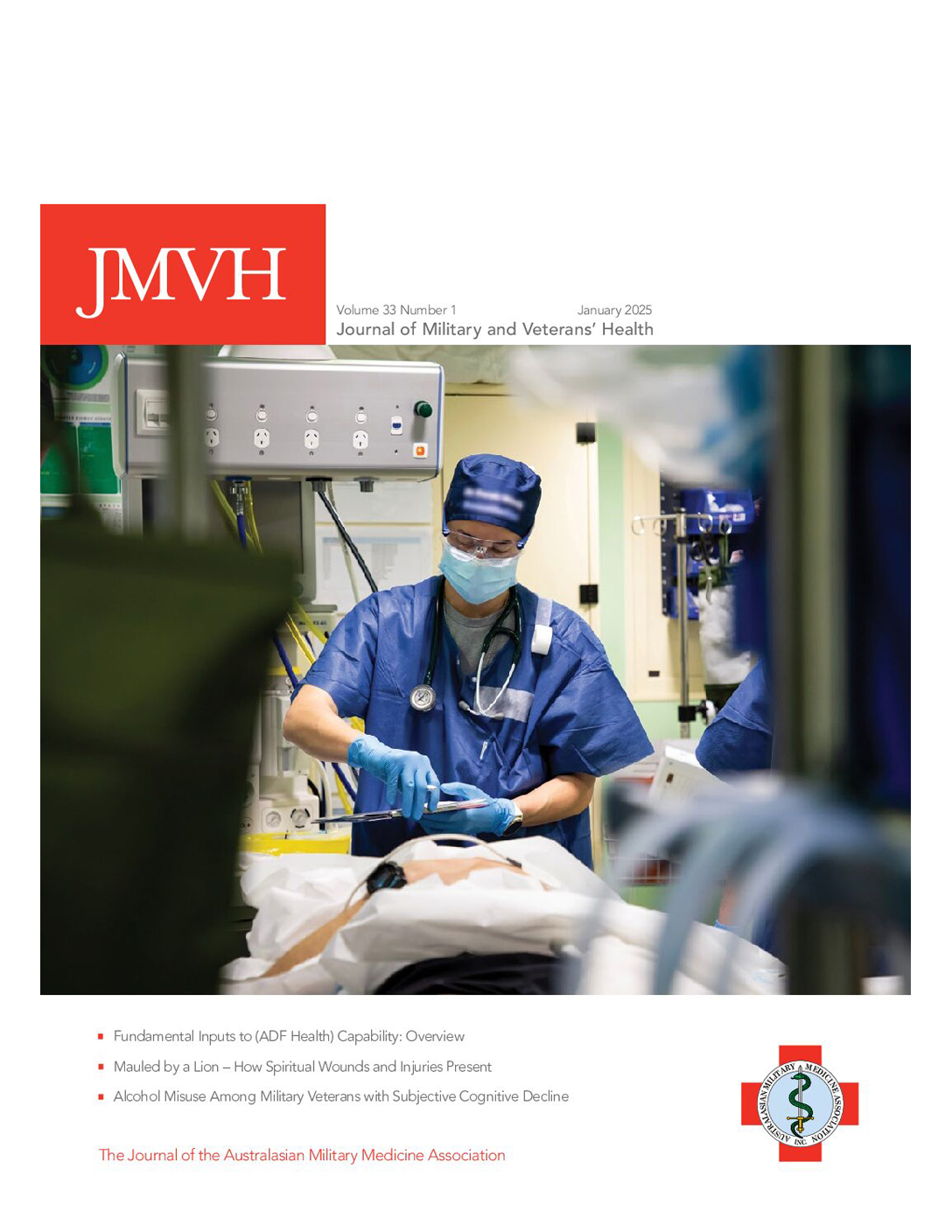Psychological Screening in the Australian Defence Force: An Historical and Contemporary Analysis of what Works
Abstract With a rapid and significant rise in psychological screening within the Australian Defence Force (ADF) over the past 20 years, ambiguity has developed between a psychological screen and a psychological assessment used for pre-employment and pre-deployment selection purposes. Additionally, confusion persists around what constitutes a mental health or psychology screen and when it should… Read more »
BATTLEFIELD LEGACIES: THE AUSTRALIAN COLLECTION OF WWI PATHOLOGICAL SPECIMENS
Hearder R. Battlefield legacies: The Australian collection of WW1 pathological specimens. Aust Mil Med 1999;. Rosalind Hearder BA (Hons) is a military medical historian who is currently doing her PhD in history at the University of Melbourne. There no longer seems to exist any documentation that records the name or nationality of patients from whom… Read more »
Australia and the Boxer Rebellion 1900 -The South Australian Contingent
Introduction August 2000 is the centenary of Australia’s involvement in the Boxer Rebellion. This was only the second and last time that the colonial naval forces saw overseas service, the first being the deployment to New Zealand by the Victorian screw sloop Victoria in 1860-1. The Boxer Rebellion was the larger deployment of the two,… Read more »
Regional Health Support Agency South Queensland Donations to AMMA Library
The Regional Health Support Agency South Queensland has, through the kind offices of the Director of Health Services, Colonel Vlas Efstathis, OAM, RFD, RAAMC, donated three books to the Australian Military Medi¬cine Association’s Library: Arms and Aesculapius Reflections and Rwanda Across the Bar The cover jacket summaries of these books follow. Each of them is… Read more »
John Keith Henderson: First Australian to Provide Dental Treatment to Troops on Active Service
Abstract The Royal Australian Army Dental Corps regards John Keith Henderson as the first Australian to provide dental treatment to troops on active service. At the time, he was a third-year dental student at the University of Sydney who had enlisted as a Private in the Australian Army Medical Corps at the outbreak of World… Read more »
Malaria During Special Forces Operations in the Indo-Pacific Region During the Second World War
Abstract Although Special Forces may expect high casualty rates, such highly-trained soldiers cannot afford infectious disease losses. During World War II, malaria often determined the extent of special operations simply by limiting the time a unit could be deployed in a tropical jungle before fever incapacitated it. During the Allied campaign against the Imperial Japanese… Read more »
Innovations from the Battlefield: Tourniquets
D Maher Abstract Background: Despite its use from Alexander the Great’s war with Persia to current conflicts in the Middle East, the tourniquet has been considered both a lifesaver and invention of the Devil. This poor reputation developed through several conflicts, from the US Civil War to Vietnam. Concerns and unfortunate dogmas from these conflicts… Read more »
Post-Traumatic Stress Disorder or Post-Traumatic Stress Injury: What’s in a name?
Abstract Background: Post-Traumatic Stress Disorder (PTSD) is a trauma-induced condition that is associated with high healthcare usage and costs, as well as long-term disability. Enabling those affected to seek diagnosis and treatment and removing barriers to care is, therefore, a significant priority. Results: In the last few years, an argument has been made that changing… Read more »
A History of Australian Navy Health Officer Uniforms and Ranks (Part Two)
Purpose More than a century after its establishment, many Royal Australian Navy (RAN) uniforms and ranks still reflect those used by the British Royal Navy (RN). Previous articles have described the history of Navy sailor uniforms or ‘rigs’ since 1509,1 the development of male and female health sailor uniforms since 1879,2 and the evolution of… Read more »
The Australian Army’s Two ‘Traditional’ Diseases: Gonorrhea and Syphilis — A Military-Medical History During the Twentieth Century
Ian Howie-Willis Abstract Two sexually transmitted diseases (STDs) marched in lockstep with the Australian Army in most, if not all, its overseas campaigns during the twentieth century. Gonorrhoea and syphilis, bacterial infections spread most commonly through sexual intercourse. This article illustrates through reference to the Australian Army’s major overseas deployments; from the Boer War at… Read more »
A History of Australian Navy Health Sailor Uniforms and Ranks (Part 3)
Commander Neil Westphalen, Royal Australian Navy Reserve Purpose More than a century after its establishment, many Royal Australian Navy (RAN) uniforms and ranks continue to reflect those used by the (British) Royal Navy (RN). The first of this three-part article described the history of Navy sailor uniforms since 1509,[i] while the second examined the development… Read more »
A History of Australian Navy Health Sailor Uniforms and Ranks (Part 2)
A History of Australian Navy Health Sailor Uniforms and Ranks (Part 2) Commander Neil Westphalen, Royal Australian Navy Reserve Purpose More than a century after its establishment, many Royal Australian Navy (RAN) uniforms and ranks still reflect those used by the (British) Royal Navy (RN).The first of this three-part article described the history of Navy… Read more »
A History of Australian Navy Health Sailor Uniforms and Ranks (Part 1)
Commander Neil Westphalen, Royal Australian Navy Reserve Purpose Mariners have been identifiable by their clothing for centuries. This reflects their ongoing need for attire that allows free movement for negotiating ladders, doorways and hatches, and performing physically demanding tasks such as hauling lines on cluttered decks and moving heavy weights. In the past, their garments… Read more »
‘A near-run thing’: The foundation and early years of 1 Malaria Research Laboratory, forerunner of the Australian Army Malaria Institute, 1963–1969 (Part 4 of ‘Pioneers of Australian military malariology’)
Ian Howie-Willis Abstract During the 25 years following World War II, malaria re-emerged as a major threat to Australian military personnel deployed to malarious regions in South-East Asia. By 1952, malariologists in Britain knew that drug-resistant strains of the malaria parasites Plasmodium falciparum and Plasmodium vivax had emerged in Malaya.[i] Successive contingents of Australian soldiers… Read more »
Australian malariology during World War II (Part 3 of ‘Pioneers of Australian military malariology’)
Ian Howie-Willis Abstract This is the third part in a five-part series on the development of Australian military malariology during the twentieth and early twenty-first centuries. Part 1, which appeared in JMVH 24(1) in January 2016, traced the course taken by Australian malariology between the South African (‘Boer’) War of 1898–1902 and the early 1920s… Read more »
The Army Malaria Institute: Fifty Years of Esteemed “Vampire” Service
J. Pearn Abstract The Golden Jubilee (2016) of the Army Malaria Institute is a significant event in the history not only of the Australian Defence Force, but that of the Australian nation. The Institute’s research – entomological, pharmacological, epidemiological and clinical – has been crucial in the maintenance of optimal healthcare for every operational and humanitarian deployment of… Read more »
Pacific Island Societies Destabilised by Infectious Diseases
Prof G. Dennis Shanks MD1,2,3 Abstract Infectious diseases de-populated many isolated Pacific islands when they were first exposed to global pathogen circulation from the 18th century. In most cases it is difficult to reconstruct mortality risk factors as few literate observers were present when the first epidemics arrived with lethality dropping rapidly during subsequent epidemics…. Read more »
Joint Expeditionary Medical Support in 1914: The US Occupation of Veracruz, Mexico
Sanders Marble Keywords: Military Medicine/history; Military Medicine/organisation & administration; Preventive Medicine/history On Tuesday, 21 April 1914 US sailors and Marines landed at Veracruz, Mexico. There were two days of sporadic fighting by the ‘Bluejackets’ and Marines followed by almost seven months of occupation by Army and Marine forces. The two services would draw limited lessons… Read more »
Malariology in Australia between the First and Second World Wars (Part 2 of ‘Pioneers of Australian military malariology’)
Abstract Two ‘push’ factors drove Australian malariological research in the decades before World War II. The first was the nation’s own experience of malaria in its tropical north, where local, usually seasonal, outbreaks of the disease occurred fairly regularly. The second was the Army’s experience of malaria during overseas deployments. During the two inter-war decades, the… Read more »
Army Malaria Institute – Its Evolution and Achievements Fifth Decade: 2006-2015
Abstract As the Army Malaria Institute entered its fifth decade, its research mission expanded and matured. Five research departments were engaged in assessing a variety of malaria drugs, molecular biology, field, clinical and diagnostic studies while arbovirus vaccines and molecular epidemiology topics were studied. Internal and external reviews of the Army Malaria Institute (AMI) were conducted indicating that… Read more »






